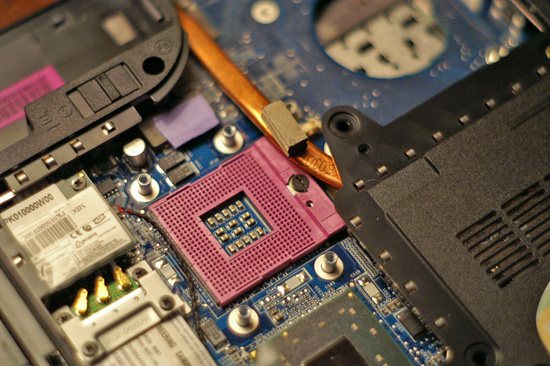Intel Santa Rosa Preview: Centrino V Evolves
by Anand Lal Shimpi on May 10, 2007 12:00 AM EST- Posted in
- Laptops
Final Words:
Intel's Centrino platform has been the sum of a series of evolutionary steps, each building on a very solid foundation originally introduced in 2003. Each step along the way brought us new technologies, better performance, and longer battery life. Unfortunately, with such high expectations for constant improvements in performance and power efficiency, it's not too difficult to feel let down by Santa Rosa; there's simply no tangible performance improvement for the vast majority of applications. For the first Centrino platform with no major CPU enhancements, we have to look to the platform for the real attraction to Santa Rosa.

The inclusion of 802.11n is a nice feature, however later versions of Intel's Napa Centrino platform began shipping with 802.11n support, which steals some of Santa Rosa's thunder. Santa Rosa does bring improved integrated graphics, in theory, but without being able to test it we're unsure of its impact on notebook usability and battery life.
That leaves Intel's Turbo Memory as the saving grace for the platform. While we would love to give you the final verdict on Intel's Turbo Memory today, we simply can't. From what we've seen, it's unimpressive, however Intel does claim that we should be seeing more than what we are. When we find out why, you'll be the first to know, until then - we see no reason to upgrade.
If you're in the market for a new notebook anyway, Santa Rosa becomes a lot more attractive. It comes with all the latest features, and with NVIDIA's newly launched GeForce 8M Series you could get DirectX 10 support in the mix as well. Assuming relative price parity between Napa and Santa Rosa notebooks, there's quite a bit of new hardware available starting today. If you've been waiting for the right time to buy a new notebook, your wait may be drawing to a close. If you already have a decent laptop, however, we wouldn't rush out to replace it anytime soon.
Intel's Centrino platform has been the sum of a series of evolutionary steps, each building on a very solid foundation originally introduced in 2003. Each step along the way brought us new technologies, better performance, and longer battery life. Unfortunately, with such high expectations for constant improvements in performance and power efficiency, it's not too difficult to feel let down by Santa Rosa; there's simply no tangible performance improvement for the vast majority of applications. For the first Centrino platform with no major CPU enhancements, we have to look to the platform for the real attraction to Santa Rosa.

The inclusion of 802.11n is a nice feature, however later versions of Intel's Napa Centrino platform began shipping with 802.11n support, which steals some of Santa Rosa's thunder. Santa Rosa does bring improved integrated graphics, in theory, but without being able to test it we're unsure of its impact on notebook usability and battery life.
That leaves Intel's Turbo Memory as the saving grace for the platform. While we would love to give you the final verdict on Intel's Turbo Memory today, we simply can't. From what we've seen, it's unimpressive, however Intel does claim that we should be seeing more than what we are. When we find out why, you'll be the first to know, until then - we see no reason to upgrade.
If you're in the market for a new notebook anyway, Santa Rosa becomes a lot more attractive. It comes with all the latest features, and with NVIDIA's newly launched GeForce 8M Series you could get DirectX 10 support in the mix as well. Assuming relative price parity between Napa and Santa Rosa notebooks, there's quite a bit of new hardware available starting today. If you've been waiting for the right time to buy a new notebook, your wait may be drawing to a close. If you already have a decent laptop, however, we wouldn't rush out to replace it anytime soon.










22 Comments
View All Comments
avaughan - Thursday, May 10, 2007 - link
I would have thought that the real benefit from Robson would have been the power savings from the ability for the OS to write todisk/save something/do a small amount of swapping without needing to spin up the hard disk.
Regarding performance expectations, what's the read/write throughput on the flash, and is this a fast hard disk? I would expect
reading/writing a large contiguous file to/from a fast hard to be faster than reading/writing to cheap (= slow) flash.
If Vista can store part of the data on the hard disk, and the rest on flash, and read/write both chunks simultaneously
or the flash has throughput as fast/faster as the hard disk then I would hope to see performance benefits.
smn198 - Thursday, May 10, 2007 - link
Maybe it was an interesting article but I cannot read the begining of each line as there are Intel vPro dogs in the way.